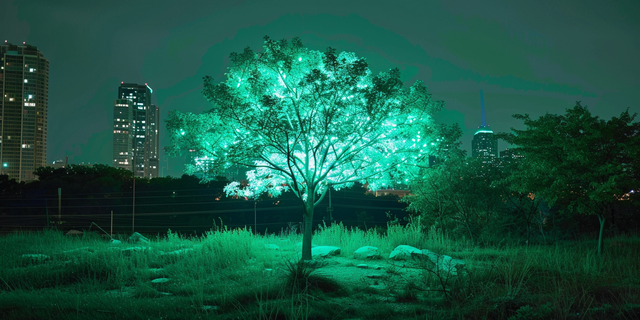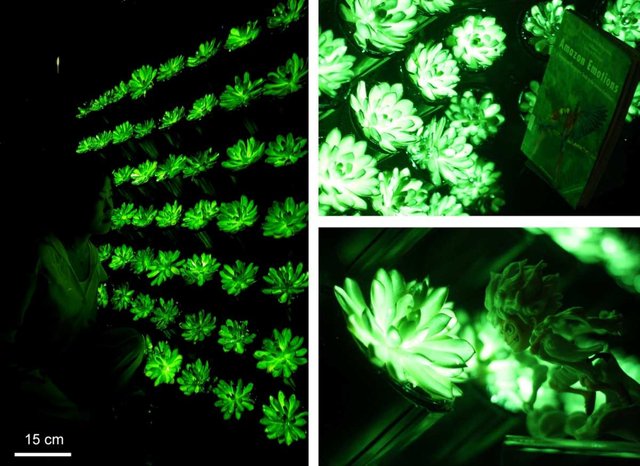Incandescent plants to replace streetlights in the cities of the future/Plantas incandescentes para reemplazar las farolas en las ciudades del futuro

Source
According to the International Energy Agency (IEA), street lighting accounts for between 15% and 19% of a typical city's total electricity consumption. It is estimated that more than $40 billion a year is spent globally on street lighting. Although LED streetlights have already reduced this consumption by 40–60% in cities that have made the transition, much of the city still uses sodium and metal halide lamps. Added to this is the light pollution that prevents us from enjoying the night skies.
Según la Agencia Internacional de la Energía (IEA), el alumbrado público representa entre el 15 % y el 19 % del consumo eléctrico total de una ciudad típica. Se estima que más de 40.000 millones de dólares al año se destinan globalmente a iluminación pública. Aunque las farolas LED han reducido ya un 40–60 % de ese consumo en ciudades que han hecho la transición, aún queda mucho parque con lámparas de sodio y halogenuros metálicos. A esto hemos de añadir la contaminación lumínica que nos impide disfrutar de los cielos nocturnos.
In this scenario, the Chinese have created incandescent plants that seek to replace conventional streetlights in cities of the future using real plants capable of emitting light, thanks to luminescent particles integrated into their tissues. Chinese scientists have managed to make certain plants, especially succulents, glow in the dark by injecting luminescent phosphor particles into their leaves, similar to those used in glow-in-the-dark toys. These particles absorb light energy during the day (from sunlight or LEDs) and slowly release it, allowing the plant to glow for several hours after charging.
En este escenario, los chinos han creado plantas incandescentes que busca reemplazar las farolas convencionales en ciudades del futuro usando plantas reales capaces de emitir luz, gracias a partículas luminiscentes integradas en sus tejidos. Los científicos chinos han logrado que ciertas plantas, sobre todo suculentas, brillen en la oscuridad inyectando en sus hojas partículas de fósforo luminiscente, similares a las que se emplean en juguetes que brillan. Estas partículas absorben energía lumínica durante el día (con luz solar o LED) y la liberan lentamente, logrando que la planta brille por varias horas después de cargar.

Source
The process does not involve any genetic modification, so the plant maintains its health, growth, and normal functions. These plants have been made to glow in various colors (green, blue, red, and warm white), allowing for not only functional but also decorative applications in urban spaces. Furthermore, they do not depend on any external power supply, so they can reduce light pollution and energy consumption in cities, while also making them more beautiful at night.
El procedimiento no implica ningún tipo de modificación genética, por lo que la planta mantiene su salud, crecimiento y funciones normales. Se ha conseguido que estas plantas brillen en varios colores (verde, azul, rojo y blanco cálido), lo que permite aplicaciones no solo funcionales sino también decorativas en espacios urbanos. Además no dependen de ningún tipo de alimentación externa por lo que pueden reducir la contaminación lumínica y el consumo energético en las ciudades además de volverlas más bonitas por las noches.
The particles used are water-resistant and compatible with plant tissue, so they do not affect normal plant growth. Converting a plant into a streetlight costs just $1.40 and takes approximately 10 minutes to charge, facilitating widespread adoption. This technology makes it possible to create illuminated green walls, informational signs, or decorative patterns that recharge daily with sunlight. However, for now, these are insufficient to replace street lighting on main avenues.
Las partículas usadas son resistentes al agua y compatibles con los tejidos vegetales, por lo que no afecta al crecimiento normal de las plantas. Convertir una planta en farola cuesta apenas 1,4 USD y tardan aproximadamente 10 minutos en cargarse, lo que facilita la adopción masiva. Con esta tecnología es posible crear muros vegetales luminosos, señalizaciones informativas o patrones decorativos que se recargan diariamente durante el día con la luz solar. Aunque por el momento son insuficientes para sustituir el alumbrado público en avenidas principales.

Source
This technology is constantly developing, and it is hoped that in the future, the intensity and duration of the glow will be increased, paving the way for potential widespread adoption for decorative and ambient urban lighting. Although skeptics warn that, at least in the short term, their use will be more decorative or informative, while performance is improved for functional applications that allow them to completely replace current streetlights. However, there is no doubt that they represent an innovative step toward sustainable urban lighting.
Esta tecnología está en constante desarrollo y se espera que en un futuro se pueda aumentar la intensidad y duración del brillo, abriendo la puerta a una posible adopción masiva para iluminación urbana decorativa y ambiental. Aunque los más escépticos advierten que, al menos a corto plazo, el uso será más decorativo o informativo, mientras se mejora el rendimiento para aplicaciones funcionales que permitan sustituir por completo las farolas actuales. Pero no cabe duda de que representan un paso innovador hacia la iluminación urbana sostenible.
But we have to be realistic: although the idea is attractive, these technologies currently generate little light and only temporarily; the energy conversion efficiency of plants is minimal (less than 2%), and a large portion of this is used to maintain their metabolism. On the other hand, LED lighting technology is advancing rapidly; they are efficient, dimmable, low-cost, and offer better color and brightness control. Much more practical than caring for bioluminescent plants. Thinking of a plant as equivalent to a light bulb is, for now, more of a science fiction concept.
Pero hemos de ser realistas, aunque la idea es bonita, hoy estas tecnologías generan poca luz y de forma temporal, la eficiencia de conversión de energía de las plantas es mínima (menos del 2 %), y buena parte se usa en mantener su metabolismo. Por otra parte, la tecnología de las luminarias LED avanzan rápido, son eficientes, regulables, de bajo costo y con mejor control de color y brillo. Mucho más prácticos que cuidar plantas bioluminiscentes. Pensar en una planta como equivalente a una bombilla es, por ahora, más un concepto de ciencia ficción.
More information/Más información
https://www.earth.com/news/glowing-plants-could-replace-street-lamps-in-future-cities/